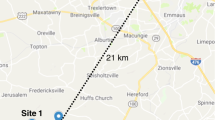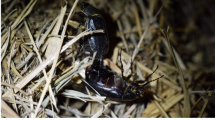Abstract
The gypsy moth Lymantria dispar (Linnaeus) is a highly polyphagous herbivore that defoliates a wide variety of tree species. The influence of age and mating status on the flight activity of females was assessed in seven geographically isolated populations from China. We examined flight activity of tethered females using a computer-linked flight mill in the laboratory and found that age significantly influenced flight parameters, including total flight distance, time, and speed. Flight distance peaked in the youngest females (at 1 day of age) and declined with age. No significant differences in flight parameters were found between unmated and mated females. Females from Guizhou showed the strongest flight activity among all seven populations. The total flight distances, flight times, and maximum flight speeds at 1 day of age were 7.50 ± 2.28 km, 2.17 ± 0.51 h, and 6.18 ± 0.51 km/h, respectively. These results provide valuable information regarding the scale and speed of dispersal in hotspots and can improve the management and control of forest damage.


Similar content being viewed by others
References
Arthur A, Bauer D (1981) Evidence of the northerly dispersal of the sunflower moth by warm winds. Environ Entomol 10:528–533. doi:10.1093/ee/10.4.528
Baranchikov Y (1988) Ecological basis of the evolution of host relationships in Eurasian gypsy moth populations. In: Wallner WE, McManus KA (eds) Proceedings of the Lymantriidae: a comparison of features of new and old world tussock moths. USDA Forest Service Northeastern Forest Experiment Station, Broomall, pp 319–338
Bartholomew GA, Casey TM (1978) Oxygen consumption of moths during rest, pre-flight warm-up, and flight in relation to body size and wing morphology. J Exp Biol 76:11–25
Briegel H, Knusel I, Timmermann S (2001) Aedes aegypti: size, reserves, survival, and flight potential. J Vector Ecol 26:21–31
Casey T (1988) Oxygen consumption during flight. In: Goldsworthy GJ, Wheeler CH (eds) Insect flight. CRC, Boca Raton, pp 257–272
Charlton R, Carde R, Wallner W (1999) Synchronous crepuscular flight of female Asian gypsy moths: relationships of light intensity and ambient and body temperatures. J Insect Behav 12:517–531. doi:10.1023/A:1020918924471
Chen H, Li Z, Tang M (2010) Laboratory evaluation of flight activity of Dendroctonus armandi (Coleoptera: Curculionidae: Scolytinae). Can Entomol 142:378–387. doi:10.4039/n10-018
Chen H, Li Z, Bu S et al (2011) Flight of the Chinese white pine beetle (Coleoptera: Scolytidae) in relation to sex, body weight and energy reserve. B Entomol Res 101:53–62. doi:10.1017/S0007485310000209
Chen F, Luo Y, Keena M et al (2016a) DNA Barcoding of gypsy moths from China (Lepidoptera: Erebidae) reveals new haplotypes and divergence patterns within gypsy moth subspecies. J Econ Entomol 109:366–374. doi:10.1093/jee/tov258
Chen F, Shi J, Shi J, Keena M (2016b) Evaluation of the effects of light intensity and time interval after the start of scotophase on the female flight propensity of Asian gypsy moth (Lepidoptera: Erebidae). Environ Entomol 45:404–409. doi:10.1093/ee/nvv222
Collatz K, Wilps H (1986) Aging of flight mechanism. In: Collatz KG, Sohal RS (eds) Insect aging. Springer, Berlin, pp 55–72
Danthanarayana W (1976) Environmentally cued size variation in the light-brown apple moth, Epiphyas postvittana (Walk.) (Tortricidae), and its adaptive value in dispersal. Oecologia 26:121–132
Elkinton J, Liebhold A (1990) Population dynamics of gypsy moth in North America. Annu Rev Entomol 35:571–596. doi:10.1007/BF00582890
Fairbairn D, Roff D (1990) Genetic correlations among traits determining migratory tendency in the sand cricket, Gryllus firmus. Evolution 44:1787–1795. doi:10.2307/2409507
Garner K, Slavicek J (1996) Identification and characterization of a RAPD-PCR marker for distinguishing Asian and North American gypsy moths. Insect Mol Biol 5:81–91. doi:10.1111/j.1365-2583.1996.tb00043.x
Gatehouse A, Hackett D (1980) A technique for studying flight behaviour of tethered Spodoptera exempta moths. Physiol Entomol 5:215–222. doi:10.1111/j.1365-2583.1996.tb00043.x
Gunn A, Gatehouse A, Woodrow K (1989) Trade-off between flight and reproduction in the African armyworm moth, Spodoptera exempta. Physiol Entomol 14:419–427. doi:10.1111/j.1365-3032.1989.tb01111.x
Hughes J, Dorn S (2002) Sexual differences in the flight performance of the oriental fruit moth, Cydia molesta. Entomol Exp Appl 103:171–182. doi:10.1046/j.1570-7458.2002.00967.x
Ishiguri Y, Shirai Y (2004) Flight activity of the peach fruit moth, Carposina sasakii (Lepidoptera: Carposinidae), measured by a flight mill. Appl Entomol Zool 39:127–131. doi:10.1303/aez.2004.127
Iwaizumi R, Arakawa K (2010) Report on female flight activity of the Asian gypsy moth, Lymantria dispar (Lepidoptera: Lymantriidae) and flight suppression with a yellow light source in Japan. Res Bull Plant Prot Jpn 46:9–15
Iwaizumi R, Arakawa K, Koshio C (2010) Nocturnal flight activities of the female Asian gypsy moth, Lymantria dispar (Linnaeus)(Lepidoptera: Lymantriidae). Appl Entomol Zool 45:121–128. doi:10.1303/aez.2010.121
Keena M, Grinberg P, Wallner W et al (2007) Inheritance of female flight in Lymantria dispar (Lepidoptera: lymantriidae). Environ Entomol 36:484–494. doi:10.1093/ee/36.2.484
Keena M, Côté M-J, Grinberg P et al (2008) World distribution of female flight and genetic variation in Lymantria dispar (Lepidoptera: Lymantriidae). Environ Entomol 37:636–649. doi:10.1603/0046-225X(2008)37[636:WDOFFA]2.0.CO;2
Lu Y, Wu K, Guo Y (2007) Flight potential of Lygus lucorum (Meyer-Dür) (Heteroptera: Miridae). Environ Entomol 36:1007–1013. doi:10.1093/ee/36.5.1007
Matsuki M, Kay M, Serin J, Floyd R et al (2001) Potential risk of accidental introduction of Asian gypsy moth (Lymantria dispar) to Australasia: effects of climatic conditions and suitability of native plants. Agric For Entomol 3:305–320. doi:10.1046/j.1461-9555.2001.00119.x
Muhamad O, Tsukuda R, Oki Y et al (1994) Influences of wild crucifers on life history traits and flight ability of the diamondback moth, Plutella xylostella (Lepidoptera: yponomeutidae). Res Popul Ecol 36:53–62. doi:10.1007/BF02515085
Pfeifer TA, Humble LM, Ring M et al (1995) Characterization of gypsy moth populations and related species using a nuclear DNA marker. Can Entomol 127:49–58. doi:10.4039/Ent12749-1
Sandquist R, Richerson J, Cameron EA (1973) Flight of North American female gypsy moths. Environ Entomol 2:957–958. doi:10.1093/ee/2.5.957
Schumacher P, Weyeneth A, Weber D et al (1997) Long flights in Cydia pomonella L. (Lepidoptera: tortricidae) measured by a flight mill: influence of sex, mated status and age. Physiol Entomol 22:149–160. doi:10.1111/j.1365-3032.1997.tb01152.x
Shirai Y (1993) Factors influencing flight ability of male adults of the Diamondback Moth, Plutella xylostella, with special reference to temperature conditions during the larval Stage. Appl Entomol Zool 28:291–301. doi:10.1303/aez.28.291
Shirai Y (2006) Flight activity, reproduction, and adult nutrition of the beet webworm, Spoladea recurvalis (Lepidoptera: Pyralidae). Appl Entomol Zool 41:405–414. doi:10.1303/aez.2006.405
Tanaka K, Yamanaka T (2009) Factors affecting flight activity of Ophraella communa (Coleoptera: Chrysomelidae), an exotic insect in Japan. Environ Entomol 38:235–241. doi:10.1603/022.038.0129
Taylor R, Bauer L, Poland T et al (2010) Flight performance of Agrilus planipennis (Coleoptera: Buprestidae) on a flight mill and in free flight. J Insect Behav 23:128–148. doi:10.1007/s10905-010-9202-3
Tu Y, Wu K, Xue F et al (2010) Laboratory evaluation of flight activity of the common cutworm, Spodoptera litura (Lepidoptera: Noctuidae). Insect Sci 17:53–59. doi:10.1111/j.1744-7917.2009.01281.x
Venette R, Ragsdale D (2004) Assessing the invasion by soybean aphid (Homoptera: Aphididae): where will it end? Ann Entomol Soc Am 97:219–226. doi:10.1093/aesa/97.2.219
Willers J, Schneider J, Ramaswamy S (1987) Fecundity, longevity and caloric patterns in female Heliothis virescens: changes with age due to flight and supplemental carbohydrate. J Insect Physiol 33:803–808. doi:10.1016/0022-1910(87)90027-8
Wu H, Wu K, Wang D et al (2006) Flight potential of pink bollworm, Pectinophora gossypiella Saunders (Lepidoptera: Gelechiidae). Environ Entomol 35:887–893. doi:10.1603/0046-225X-35.4.887
Yang ZQ, Zhang YA (2007) Researches on techniques for biocontrol of the fall webworm, Hyphantria cunea, a severe invasive insect pest to China. Chin Bull Entomol 4:003
Yang F, Luo Y, Huang D et al (2012) A preliminary study on flight ability among Chinese population of Asian gypsy moth, Lymantria dispar. Chin Agr Sci Bull 28:53–57 (In Chinese with english summary)
Acknowledgements
We thank Fang Chen, De-Peng Wang, and Yang Li for their help in sample collection. We also thank Prof. Zhi-Chun Xu for establishing the flight mill system and providing helpful suggestions in this study, and thank Dr. M. Takeda for comments that improved the quality of the manuscript. This work was funded by Beijing Higher Education Young Elite Teacher Project (YETP0740), and the Fundamental Research Funds for the Central Universities (NO. 2016ZCQ07).
Author information
Authors and Affiliations
Corresponding author
Rights and permissions
About this article
Cite this article
Yang, F., Luo, Y. & Shi, J. The influence of geographic population, age, and mating status on the flight activity of the Asian gypsy moth Lymantria dispar (Lepidoptera: Erebidae) in China. Appl Entomol Zool 52, 265–270 (2017). https://doi.org/10.1007/s13355-016-0475-7
Received:
Accepted:
Published:
Issue Date:
DOI: https://doi.org/10.1007/s13355-016-0475-7




